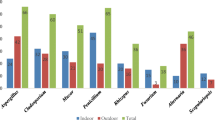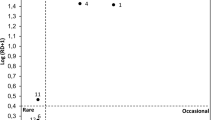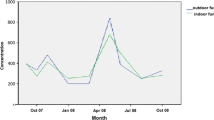Abstract
Penicillium andAspergillus have been recognized as important aeroallergens for more than 30 years, and are especially significant in indoor environments. There are over 400 species ofPenicillium andAspergillus combined, but there is little information on which species occur most frequently in the environment, or if each exhibits unique allergenic properties. A preliminary study showed no overlap between those species isolated from an outdoor site in Tulsa, Oklahoma and the species used in immunotherapy at allergy clinics in the Tulsa area. Pursuing this line of research, air samples were collected as three seasonal samples (over a 6 month period) in the homes or offices of ten allergy patients known to be allergic toPenicillium and/orAspergillus. Twenty three species ofPenicillium and 12 species ofAspergillus were identified from these samples through isolation, macroscopic, and microscopic examination.Penicillium corylophilum, P. glabrum, Aspergillus niger, andA. flavipes were the most abundant species isolated, supporting the data obtained in a preliminary study. At least in the Tulsa area, it appears that atopic patients are being tested and treated with extracts ofPenicillium andAspergillus species that are either not present or not abundant in the local indoor or outdoor environments. Additional research is necessary to determine if the environmental isolates share allergens with those species used in immunotherapy.
Similar content being viewed by others
References
Burge H. Fungus allergens. Clin Rev Allergy 1985;3:319–29.
Burge H. Bioaerosols: prevalence and health effects in the indoor environment. J Allergy Clin Immunol 1990;86:687–701.
Chang J, Foarde K, Vanosdell D. Growth evaluation of fungi (Penicillium andAspergillus spp.) on ceiling tiles. Atmos Environ 1995;29:2331–7.
Cordasco E, Demeter S, Zenz C. editors. Environmental Respiratory Diseases. New York: Van Nostrand Reinhold. 1995.
Escamilla B, Mwawasi G, Comtois P, Becklake M, Ernst P. The determinants of airborne mold levels in Canadian homes. Boston ATS Abstracts 149, 1994.
Feinberg SM. Mold allergy; its importance in asthma and hay fever. Wis Med J 1935;34:254.
Frisvad J, Gravesen S.Penicillium andAspergillus from Danish homes and working places with indoor air problems: identification and mycotoxin determination. In: Health implications of fungi in indoor environments. New York: Elsevier, 1994.
Hocking AD, Pitt JI. Dichloran-glycerol medium for enumeration of xerophilic fungi from low-moisture foods. Appl Environ Microbiol 1980;39:488–92.
Klich MA, Pitt JI. A laboratory guide to commonAspergillus species and their teleomorphs. Commonwealth Scientific and Industrial Research Organization, Div. of Food Processing: Australia, 1992.
Levetin E. Fungi. In: Burge H. editor. Bioaerosols. Boca Raton, FL: Lewis Publishers, 1995:87–120.
Mishra SK, Ajello L, Ahearn DG, Burge HA, Kurup VP, Pierson DL, Price DL, Samson RA, Sandhu RS, Shelton B, Simmons RB, Switzer KF. Environmental mycology and its importance to public health. J Med Vet Mycol 1992;1 Suppl.(30):287–305.
Pitt JI. A laboratory guide to commonPenicillium species. Commonwealth Scientific and Industrial Research Organization, Div. of Food Processing: Australia, 1991.
Ramirez C. Manual and atlas of the Penicillia. New York: Elsevier Biomedical Press, 1982.
Raper, K.B., Fennell, D.I. The genusAspergillus. Malabar, FL, Robert E. Krieger Pub. Co., 1965.
Rijckaert G, Broers JL. Time dependent release of allergens from some xerophilic fungi. Allergy 1980;35:679–82.
Rosas I, Calderon C, Ulloa M, Lacey J. Abundance of airbornePenicillium CFU in relation to urbanization in Mexico city. Appl Environ Microbiol 1993;59:2648–52.
Salvaggio J, Aukrust L. Postgraduate course presentations: mold-induced asthma. J Allergy Clin Immunol 1981;68:327–46.
Samson R. Occurrence of moulds in modern living and working environments. Eur J Epidemiol 1985;1:54–61.
Wei D, Chen J, Jong S, Shen H. Indoor airbornePenicillium species in Taiwan. Curr Microbiol 1993;26:137–40.
Author information
Authors and Affiliations
Rights and permissions
About this article
Cite this article
Icenhour, C.R., Levetin, E. Penicillium andAspergillus species in the habitats of allergy patients in the Tulsa, Oklahoma area. Aerobiologia 13, 161–166 (1997). https://doi.org/10.1007/BF02694503
Received:
Accepted:
Issue Date:
DOI: https://doi.org/10.1007/BF02694503




